Hatching
Most butterfly eggs undergo colour changes as the young larvae develop within them. The eggs of the Marsh Fritillary Euphydryas aurinia for example are pale yellow when first laid, but after a day or two turn pinkish-brown, then deep crimson, and finally dark grey just before the larvae hatch. The eggs of the Orange tip Anthocharis cardamines are pure white when first laid, but turn orange within 2-3 days, then become dull grey when hatching is imminent.
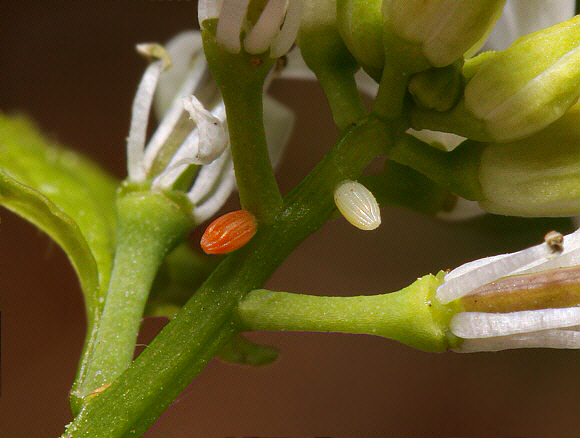
Anthocharis cardamines – the egg on the right is freshly laid – Adrian Hoskins
When a caterpillar is ready to hatch, it bites a tiny hole out of the top of the egg, and over a period of an hour or so, nibbles away until the hole is large enough to allow it to crawl out. Some species use a different technique, nibbling a circle around the perimeter of the egg to create a “lid” which is pushed upwards to allow the caterpillar to make its exit.
After hatching, some caterpillars such as that of the White-letter Hairstreak Satyrium w-album rush immediately away and eat their way into a young leaf bud or flower. Most larvae, however, stay long enough to partly devour their eggshell, which contains vital nutrients. If deprived of the opportunity to eat the eggshell, caterpillars usually die.
Feeding
For the remainder of the larval stage, most species feed on the leaves, stems, flowers, or seeds of particular plants. Some species are polyphagous, i.e., they are adapted to feed on a wide variety of plants from different botanical families.
Most, however, are monophagous, i.e., limited to feeding on just one or two closely related plant species, and unable to survive on anything else. Many species in the family Lycaenidae are carnivorous, feeding on ant grubs or aphids. This group is dealt with in detail on the cannibals, carnivores, and myrmecophiles page.

1st instar Spilosoma luteum larva nibbling tiny holes in the lower cuticle of leaf – Adrian Hoskins
Larvae and adult butterflies of any given species generally use different sources of food. For example, Marsh Fritillary caterpillars eat the leaves of devil’s bit scabious, but the adult butterflies feed on the nectar of buttercups, milkworts, and thistles. In temperate areas, the larvae and adults live at different seasons, but in the tropics, the two stages often co-exist at the same time of year, so the dichotomy between larval and adult feeding behavior enables them to avoid competing for food.
The chemical makeup of plants changes seasonally. Plants often accumulate toxins in their leaves as a means of defense against caterpillars. Older leaves are more strongly toxic and have less protein than younger leaves. Towards the end of the season, leaves may be so toxic that they can kill any caterpillar that eats them. Therefore, the larval stage of many species, particularly oak feeders, tends to be compressed into the early part of the season.
Some species which breed on less nutritional plants need to spend several months in the larval stage, so towards the end of the season, they need to search out the freshest and least toxic leaves to survive. Some species even switch to alternative host plants that come into leaf later in the year. Caterpillars often feed on different parts of their food plant at different stages in their growth.
The balance of proteins, carbohydrates, minerals, alkaloids, and essential oils in plant leaves varies considerably at different times of day. Caterpillars therefore tend to feed at specific times when the foliage is most nutritional and least toxic. Some species feed at dawn, others in mid-afternoon, and others at night.
There are further reasons why many caterpillars only feed nocturnally. Firstly, they are less likely to be preyed upon by insectivorous birds, which need daylight to locate their prey. Secondly, larvae of Satyrinae and Hesperiinae, which feed on grasses—and species which feed on herbaceous plants—are prone to be accidentally consumed by diurnal grazing animals such as rabbits, sheep, or cattle. To avoid this, they evolved to become nocturnal feeders and, in the daytime, hide away deep down in grass tussocks where grazing animals can’t reach them.
The duration of the larval stage varies according to the nutritional value of the food. Species which eat foods with high nutritional value (flowers, fruits) grow quickly, going from egg to pupa in less than a month. Species which feed on leaves take up to 2 months. This is because leaves are harder to digest, and often contain toxins that need to be processed. Slower still are the species which feed on grasses, bamboos, palms, or roots, all of which are low in nutrients and particularly difficult to digest. In these species, the larval stage usually lasts at least 3 months.
In the case of species from temperate regions, growth is often so slow that the larvae are unable to complete their development during the summer and have to hibernate and resume feeding the following spring.
Moulting
Depending on the species, caterpillars increase their body weight between about 60-200x in the period between hatching and pupating. As it feeds and grows, a caterpillar’s elasticated skin periodically becomes too tight and has to be moulted and replaced with a looser, baggy, elastic second skin that forms under the outer skin. Moulting is triggered by nerve cells called scolopidia, which detect stretch in the skin between the caterpillar’s segments.
Two or three days before moulting, caterpillars anchor themselves either to a small button of silk which they have spun on a leaf or twig, or to a silk web spun over the foodplant.
A day or two prior to moulting, the soft tissues within the caterpillar’s head retract, forming a new head capsule which is temporarily housed within the first thoracic segment. When moulting takes place, the old head shell slides forward and drops off. The old skin then splits just behind the head, allowing the caterpillar to walk forward out of its former costume.
At first, the new skin is loose and soft, leaving the larva highly vulnerable to attack by parasitoid wasps and flies. The larva slowly inflates its body by drawing in air through the spiracles. After a couple of hours, the larva’s mandibles (jaws) have hardened, at which point a larva will often eat its old skin. Another 2 hours or so later, the skin has toughened sufficiently to allow the larva to walk about without injuring itself, and to resume normal feeding.
The stages between moults are known as instars. Caterpillars of the family Lycaenidae usually have 4 instars. Those of the Hesperiidae, Nymphalidae, Papilionidae, and Pieridae usually have 5 instars. The Riodinidae have between 6-8 larval instars according to species.
Leaf-miners
The newly hatched larvae of some moths, known as “leaf-miners,” burrow into leaves and spend their entire lives living and feeding between the upper and lower membranes. Each species leaves its own characteristic trail as it weaves its way about between the membranes. When the larva is fully grown, it emerges and pupates on the surface of the leaf.
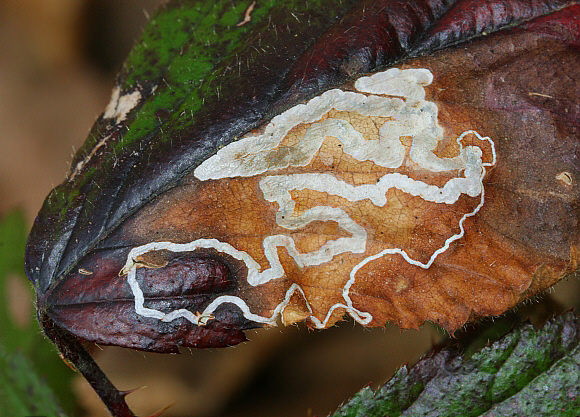 Leaf-mines produced by caterpillars of the moth Stigmella aurella – Adrian Hoskins
Leaf-mines produced by caterpillars of the moth Stigmella aurella – Adrian Hoskins
Not all caterpillars feed on living flowers or leaves. Calycopis and Detritivora, for example, feed on dead vegetation on the forest floor, while some moths such as Cossus cossus live within tunnels in the trunks of dying trees, chewing their way through solid wood.
Larval webs and shelters
The caterpillars of many butterflies, including Peacock, Small Tortoiseshell, and Marsh Fritillary, live gregariously. They spend most of their lives within substantial silk webs. They emerge periodically to feed, but then retire to the silken shelter where they are protected from predators, parasitoids, and severe weather. These species tend to molt synchronously, after which they move as a group to another clump of foliage where they spin another web.
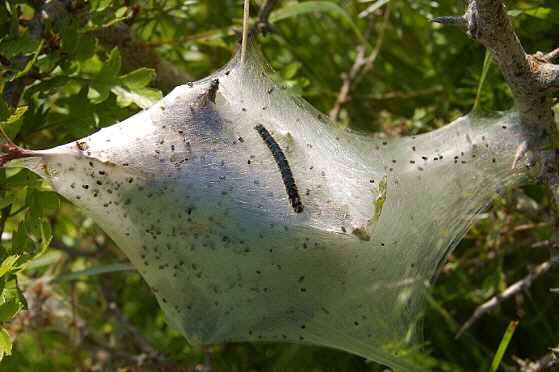 The communal web of the Small Eggar caterpillar ( Lasiocampidae ) – Adrian Hoskins
The communal web of the Small Eggar caterpillar ( Lasiocampidae ) – Adrian Hoskins
Many other species live solitarily and construct individual shelters or tents in which they hide while resting. These include skipper butterflies (Hesperiidae), Pyralid moths (Pyralidae), and Charaxine butterflies in the genera Memphis and Consul. The latter hide in rolled leaves and plug the entrance with their head capsule. This is sclerotized and too hard to be pierced by the ovipositor of parasitoid wasps. Other parasitoids such as Tachinid flies cannot gain access to lay eggs on the larva’s body, and the secrecy provided by hiding in the shelter also undoubtedly confers a degree of protection from birds and other foraging predators.
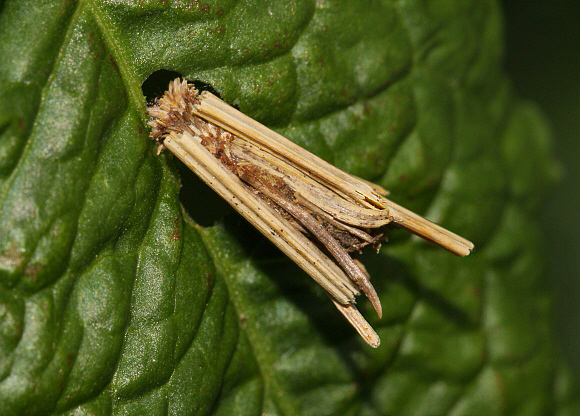 Case-bearing larva of bagworm moth Psyche casta ( Psychidae ) Berkshire, UK – Adrian Hoskins
Case-bearing larva of bagworm moth Psyche casta ( Psychidae ) Berkshire, UK – Adrian Hoskins
Bagworms
Some of the most primitive and interesting larvae are those of the case-bearers (Coleophoridae) and bagworm moths (Psychidae). These species provide part of the evidence that links butterflies and moths (Lepidoptera) to the insects from which they evolved, i.e., caddisflies (Trichoptera).
In common with caddis larvae, the caterpillars of Coleophoridae and Psychidae construct shelters or bags made from silk and natural materials such as dead leaves, bits of wood, lichens, or grains of sand. The cases have a tubular exit hole at the front end, and a small hole at the rear from where excrement is ejected. The larvae never leave their cases, so as they grow, they have to continually add more material to the front of the case to accommodate their increasing size.
When moving from place to place, the larvae anchor themselves to the inside of the case with their anal claspers and extend the front of their bodies out of the case, just far enough to allow them to grab hold of the substrate with their three pairs of true legs to haul themselves along.
The larvae within the cases are all very plain creatures, so it is usually easier to identify a bagworm or case-bearer from the design of the case, which is different for every species. The cases measure from about 1cm in the smaller temperate species, up to 15cms in some tropical species.
When the caterpillar is fully grown, it secures the case to a twig or branch, and pupation takes place within the case. Male moths are winged, but females of most species are wingless and usually don’t possess antennae, eyes, or legs. Females never leave their larval case. When copulating, the male reaches into the case with his abdomen to make sexual contact. The female lays her eggs inside the case and then dies.
The female of one species, the Evergreen bagworm Thyridopteryx ephemeraeformis, dies without laying eggs. Its tiny caterpillars emerge direct from the female body inside the case. Some species are parthenogenetic, i.e., their eggs develop without male fertilization.
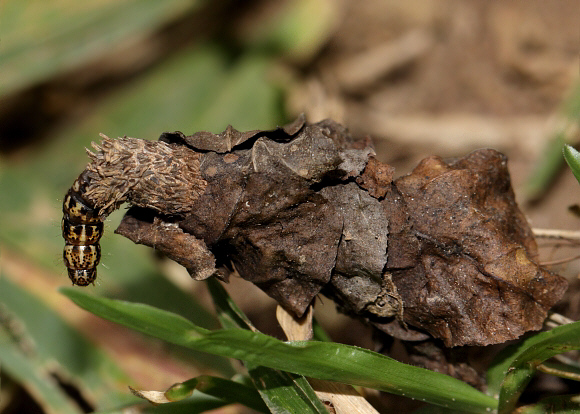 Larva of unidentified bagworm moth, Bobiri, Ghana – Adrian Hoskins
Larva of unidentified bagworm moth, Bobiri, Ghana – Adrian Hoskins
Sexual Development
As larvae grow and mature, they begin to develop sexual organs internally, but it is not possible to determine the sex of a larva from its external appearance. However, there are some species of Lepidoptera in which the larvae that will ultimately become males have 4 instars, while those that will become females have 5 instars.
An example is the Vapourer moth Orgyia antiqua, in which the female larvae grow to a much larger size than the males. The male moth looks much like any other moth, but the female is wingless and has an enormous abdomen swollen with hundreds of eggs.
Duration
In tropical regions, larvae can develop very rapidly, and in some species, the entire larval period may be as short as 2 weeks. In temperate regions, the larval stage usually lasts about 6 weeks, but is often much longer. Many species, particularly amongst the Satyrinae, overwinter as larvae, taking several months to mature. There are even a few sub-Arctic species in which the larval stage can last for 2 years.
